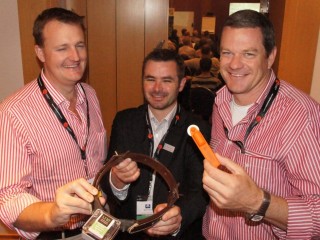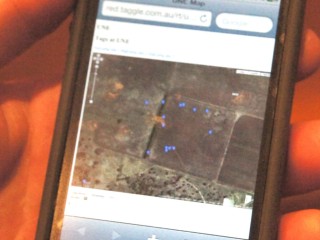 An international gathering of agricultural engineers on the Gold Coast yesterday provided a glimpse into the future possibilities for the beef industry, where remote monitoring of livestock presents itself as a means of driving greater efficiency and productivity.
An international gathering of agricultural engineers on the Gold Coast yesterday provided a glimpse into the future possibilities for the beef industry, where remote monitoring of livestock presents itself as a means of driving greater efficiency and productivity.
The technology has already come an enormous distance from the days when each apparatus used to remotely monitor a beast could cost 30,000 English Pounds.
Currently there are a range of ‘autonomous spatial livestock monitoring’ systems (ASLMs) in development, or approaching commercial launch.
One Canadian-based system was commencing trials this year, while the Syrian company was going through regulatory telecommunications work on its GPS-satellite based tracking devices, due for launch about 2013. Australian company Taggle was running trials already, and was likely to be the first to hit the market in terms of a true commercial product. At least one other company is in early development work.
Dr Mark Trotter from the University of New England’s Precision Agriculture Research Group and CRC for Spatial Information told the gathering that despite years of development as a research tool, and millions of dollars invested by commercial technology companies, there remained a large body of research to be undertaken in understanding how ASLM could best be applied in commercial cattle enterprises.
 Despite that, a lot of potential producer benefits had already been identified in simple geo-location of animals at any given time.
Despite that, a lot of potential producer benefits had already been identified in simple geo-location of animals at any given time.
“Have the cattle gone off the property through a broken fence? Have they gotten into a recently sprayed paddock? Is there theft involved? Is there a risk of predation from wild dogs? All of these can be identified through SMS alerts to a user’s Smartphone,” Dr Trotter said.
“Just being able to inform an operator that an animal has been left behind in a muster could mean a significant amount of money to a larger-scale beef producer.”
Automation of paddock grazing utilisation records was another area where a lot of interest was being focussed.
“How many animals spent how many days in which paddocks? Producers love that sort of data, but it is really hard to record using conventional systems. ASLM will allow information like that to be presented automatically, and this prospect is already attracting a lot of interest,” Dr Trotter said.
Another possible category of application was in behaviour modelling, where animal movements are seen to change from normal patterns. The biggest of these was possibly in disease detection, in risk areas like bloat, but could also be used in chronic diseases like parasite management, or animals experiencing calving difficulty. There could also be whole-of-life animal welfare implications which could be used as a marketing tool.
Temperament and socialisation detection, where rogue individuals in a mob causing problems could be removed, allowing the rest of the mob to return to a regular grazing routine and maintain productivity was another prospect. ASLM could also be applied in monitoring the degree of socialisation in a backgrounding operation, before sending cattle to a feedlot to avoid subsequent stress problems.
Of enormous potential benefit to the northern beef herd, along with other reproductive traits would be oestrus detection. Bull performance monitoring was another strong area of interest.
Simply being able to identify if a bull was still alive, and working or sitting under a tree, had strong commercial implications, and the technology had the potential to address such issues.
Genetic matching in multi-sire herds was another prospect, as was linking dams and their heifers.
Modelling grazing behaviour was further application, currently under trial. Dr Trotter said one of the areas being researched was changes in stock movement behaviour as feed in a paddock runs out – effectively, creating an alert system to enable producers to know when to rotate those animals onto another site, or when they may have missed a rotation.
He illustrated that with maps showing distinctly different plotted movement comparisons in the same paddock over a month-long cycle, as feed reserves declined. Again, this could one day be linked to SMS phone alerts when changing paddock behaviour reached a pre-determined point.
Sundown Pastoral Company in NSW was one early adopter which was exploring some of these operational efficiencies using animals fitted with ASLM devices.
A more complex application issue faced by the new technologies, but one with a lot of potential benefit, was in landscape information, Dr Trotter said.
ASLM held great potential to increase the productivity, efficiency and sustainability of grazing systems, in really tweaking how herds and pastures are managed, he said.
In work with Sundown Pastoral, some interesting trends were emerging in livestock movements, overlaid with maps for soil moisture, biomass and grazing preference. That could lead to decisions like variable fertiliser application rates in different zones. In other paddocks, the data showed lots of biomass, but little utilisation, indicating the feed had gone rank, leading to management decisions like slashing, re-fencing or supplementation.
Such data could also be used in a longer-term environmental stewardship sense, in being able to provide tangible evidence of grazing sustainability through stock access and density in areas of different biomass. Strategic placement of waters and how it affects grazing pressure could also be monitored.
“So where to now for the ASLM technology in how it applies to the beef industry?” Dr Trotter asked.
“There are some low-hanging fruit that producers are keen to see developed among the activities mentioned earlier. But equally, we need a really solid review by the industry to work out what technology is out there, where it’s up to, and how it might best be utilised.”
During question-time, Dr Trotter said while there was potential for some ‘big hits’ in terms of applications like pasture utilisation, he thought the ASLM systems would perhaps provide lots of smaller incremental gains across a number of issues to commercial beef producers, rather one or two big leaps forward. But when combined, these incremental gains would add up to a big productivity saving.
The same technologies could be attached to quad bikes or horses, for example, providing indicators in the event of an accident, and giving whole new areas of benefit in fields like workplace health and safety.
“As these systems come into play, there is a clear need for expertise in this field, to deliver the information and interpretation to graziers, and this might be an opportunity to bring young people interested in this field into agriculture,” Dr Trotter said.
Producers' view:
A small sample of beef producers also sat in on the conference, interested in gauging where the future potential might lie within the remote monitoring technologies.
Troy Setter from the Australian Agricultural Company said as the industry pushed more precision and chased increased returns within the beef business, it would need to embrace new technologies that had potential to improve productivity and reduce costs.
Initially, with ASLM, that was likely to apply in grazing management and the logistics of where the cattle were at any given time. Why they grazed where they chose could follow. Bull location and monitoring and mustering were other obvious areas of interest.
David Goodfellow from Paraway Pastoral Co saw the technology as a logical progression from NLIS tag data collection. GPS-based data collection was a large step ahead from that, particularly in much better understanding of grazing patterns of livestock across extensive areas of Australia, and how to get better utilisation from grasslands.
The rate of technological progress in ASLM was rapid, and the industry was taking the first step into a terrific area of opportunity, Mr Goodfellow said.
-
• Watch for an upcoming report in Beef Central on recent research into ‘virtual fencing systems’, and how they might be applied in the commercial cattle industry, also discussed at the conference.
